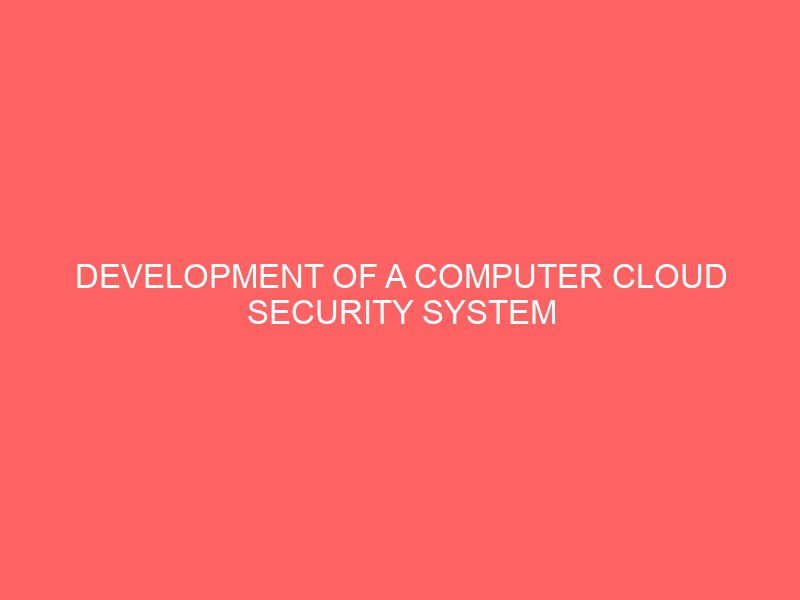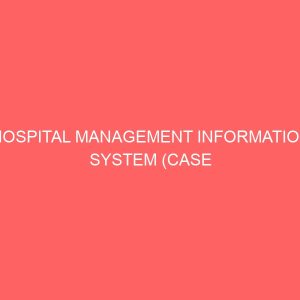Description
Cloud Computing is a flexible, cost effective, and proven delivery platform for providing business or consumer IT services over the Internet. However, cloud Computing presents an added level of risk because essential services are often outsourced to a third party, which makes it harder to maintain data security and privacy, support data and service availability, and demonstrate compliance. Cloud Computing leverages many technologies SOA, virtualization, Web 2.0; it also inherits their security issues, which we discuss here, identifying the main vulnerabilities in this kind of systems and the most important threats found in the literature related to Cloud Computing and its environment as well as to identify and relate vulnerabilities and threats with possible solutions.
CHAPTER ONE
1.0Introduction
The importance of Cloud Computing is increasing and it is receiving a growing attention in the scientific and industrial communities. A study by Gartner 2011 considered Cloud Computing as the first among the top 10 most important technologies and with a better prospect in successive years by companies and organizations.
Cloud Computing enables ubiquitous, convenient, ondemand network access to a shared pool of configurable computing resources e.g., networks, servers, storage, applications, and services that can be rapidly provisioned and released with minimal management effort or service provider interaction.
Cloud Computing appears as a computational paradigm as well as a distribution architecture and its main objective is to provide secure, quick, convenient data storage and net computing service, with all computing resources visualized as services and delivered over the Internet Zhao G, Liu J, Tang Y:2011, Zhang S, Zhang S:2012:p342. The cloud enhances collaboration, agility, scalability, availability, ability to adapt to fluctuations according to demand, accelerate development work, and provides potential for cost reduction through optimized and efficient computing Marinos A, Briscoe G:2011:p53.
Cloud Computing combines a number of computing concepts and technologies such as Service Oriented Architecture SOA, Web 2.0, virtualization and other technologies with reliance on the Internet, providing common business applications online through web browsers to satisfy the computing needs of users, while their software and data are stored on the servers Marinos A, Briscoe G:2009:p93. In some respects, Cloud Computing represents the maturing of these technologies and is a marketing term to represent that maturity and the services they provide Centre for the Protection of National Infrastructure:2010.
Although there are many benefits to adopting Cloud Computing, there are also some significant barriers to adoption. One of the most significant barriers to adoption is security, followed by issues regarding compliance, privacy and legal matters 8. Because Cloud Computing represents a relatively new computing model, there is a great deal of uncertainty about how security at all levels e.g., network, host, application, and data levels can be achieved and how applications security is moved to Cloud Computing Rosado DG, Gmez R, Mellado D:2012:p12. That uncertainty has consistently led information executives to state that security is their number one concern with Cloud Computing Mather T, Kumaraswamy S:2009:p43.
Security concerns relate to risk areas such as external data storage, dependency on the public internet, lack of control, multitenancy and integration with internal security. Compared to traditional technologies, the cloud has many specific features, such as its large scale and the fact that resources belonging to cloud providers are completely distributed, heterogeneous and totally virtualized. Traditional security mechanisms such as identity, authentication, and authorization are no longer enough for clouds in their current form Li W, Ping L:2009:p45. Security controls in Cloud Computing are, for the most part, no different than security controls in any IT environment. However, because of the cloud service models employed, the operational models, and the technologies used to enable cloud services, Cloud Computing may present different risks to an organization than traditional IT solutions. Unfortunately, integrating security into these solutions is often perceived as making them more rigid Cloud Security Alliance:2012.
Moving critical applications and sensitive data to public cloud environments is of great concern for those corporations that are moving beyond their data centers network under their control. To alleviate these concerns, a cloud solution provider must ensure that customers will continue to have the same security and privacy controls over their applications and services, provide evidence to customers that their organization are secure and they can meet their servicelevel agreements, and that they can prove compliance to auditors Rittinghouse JW:2009:p123.
We present here a categorization of security issues for Cloud Computing focused in the socalled SPI model SaaS, PaaS and IaaS, identifying the main vulnerabilities in this kind of systems and the most important threats found in the literature related to Cloud Computing and its environment. A threat is a potential attack that may lead to a misuse of information or resources, and the term vulnerability refers to the flaws in a system that allows an attack to be successful. There are some surveys where they focus on one service model, or they focus on listing cloud security issues in general without distinguishing among vulnerabilities and threats. Here, we present a list of vulnerabilities and threats, and we also indicate what cloud service models can be affected by them. Furthermore, we describe the relationship between these vulnerabilities and threats; how these vulnerabilities can be exploited in order to perform an attack, and also present some countermeasures related to these threats which try to solve or improve the identified problems.
The remainder of the paper is organized as follows: Section 2 presents the results obtained from our systematic review. Next, in Section 3 we define in depth the most important security aspects for each layer of the Cloud model. Later, we will analyze the security issues in Cloud Computing identifying the main vulnerabilities for clouds, the most important threats in clouds, and all available countermeasures for these threats and vulnerabilities. Finally, we provide some conclusions.
1.1 Background of Study
Several trends are opening up the era of Cloud Computing, which is an Internetbased development and use of computer technology. The ever cheaper and more powerful processors, together with the software as a service SaaS computing architecture, are transforming data centers into pools of computing service on a huge scale. The increasing network bandwidth and reliable yet flexible network connections make it even possible that users can now subscribe high quality services from data and software that reside solely on remote data centers.
Moving data into the cloud offers great convenience to users since they dont have to care about the complexities of direct hardware management. The pioneer of Cloud Computing vendors, Amazon Simple Storage Service S3 and Amazon Elastic Compute Cloud EC2 are both well known examples. While these internetbased online services do provide huge amounts of storage space and customizable computing resources, this computing platform shift, however, is eliminating the responsibility of local machines for data maintenance at the same time. As a result, users are at the mercy of their cloud service providers for the availability and integrity of their data. Recent downtime of Amazons S3 is such an example . From the perspective of data security, which has always been an important aspect of quality of service, Cloud Computing inevitably poses new challenging security threats for number of reasons. Firstly, traditional cryptographic primitives for the purpose of data security protection can not be directly adopted due to the users loss control of data under Cloud Computing. Therefore, verification of correct data storage in the cloud must be conducted without explicit knowledge of the whole data. Considering various kinds of data for each user stored in the cloud and the demand of long term continuous assurance of their data safety, the problem of verifying correctness of data storage in the cloud becomes even more challenging. Secondly, Cloud Computing is not just a third party data warehouse. The data stored in the cloud may be frequently updated by the users, including insertion, deletion, modification, appending, reordering, etc. To ensure storage correctness under dynamic data update is hence of paramount importance. However, this dynamic feature also makes traditional integrity insurance techniques futile and entails new solutions. Last but not the least, the deployment of Cloud Computing is powered by data centers running in a simultaneous, cooperated and distributed manner. Individual users data is redundantly stored in multiple physical locations to further reduce the data integrity threats. Therefore, distributed protocols for storage correctness assurance will be of most importance in achieving a robust and secure cloud data storage system in the real world. However, such important area remains to be fully explored in the literature.
1.2Statement of Problem
Cloud computing has become a social phenomenon used by most people every day. As with every important social phenomenon there are issues that limit its widespread adoption.
Most issues start from the fact that the user loses control of his or her data, because it is stored on a computer belonging to someone else the cloud provider. This happens when the owner of the remote servers is a person or organization other than the user; as their interests may point in different directions for example, the user may wish that his or her information is kept private, but the owner of the remote servers may want to take advantage of it for their own business.
1.3Objective of the Study
Due to the issue of security and privacy on cloud computer the researcher objectives to this study are as fellows.
Design an encryption system attached to the system that will enable any user before sending data to the cloud be encrypted with security key
Device a means of sharing data in a more secure and reliable manner over the cloud system.
Create the awareness of the security threats in cloud computer to the people so as the alert them on how to secure there information.
1.4Motivation/Research Thoughts
The question focus was to identify the most relevant issues in Cloud Computing which consider vulnerabilities, threats, risks, requirements and solutions of security for Cloud Computing. This question had to be related with the aim of this work; that is to identify and relate vulnerabilities and threats with possible solutions. Therefore, the research question addressed by our research was the following: What security vulnerabilities and threats are the most important in Cloud Computing which have to be studied in depth with the purpose of handling them The keywords and related concepts that make up this question and that were used during the review execution are: secure Cloud systems, Cloud security, delivery models security, SPI security, SaaS security, Paas security, IaaS security, Cloud threats, Cloud vulnerabilities, Cloud recommendations, best practices in Cloud. This lead into this research work by the researcher.
1.5Significance of the Study
Enlighten the people, the users of cloud computer on the security challenges and how to resolve this issues. Enhance the use and the effectiveness of the cloud computing among the people. Remove the fear of using cloud computing from the people since the research will come up with a new design that will solve the issue of privacy and third party
1.6Abbreviation/Definition
OOPS Object Oriented Programming Concepts
TCP/IP Transmission Control Protocol/Internet Protocol
JDBC Java Data Base Connectivity
EIS Enterprise Information Systems
BIOS Basic Input/Output System
RMI Remote Method Invocation
JNDI Java Naming and Directory Interface
ORDBMS Object Relational Database Management System
CSP Cloud Service Provider CSP
J2ME Java 2 Micro Edition
Reference
Gartner Inc: Gartner identifies the Top 10 strategic technologies for 2011. Online. Available: . Accessed: 15Jul2011 http://www.gartner.com/it/page.jspid1454221 Online. Available: . Accessed: 15Jul2011
Zhao G, Liu J, Tang Y, Sun W, Zhang F, Ye X, Tang N: Cloud Computing: A Statistics Aspect of Users. In First International Conference on Cloud Computing CloudCom, Beijing, China. Heidelberg: Springer Berlin; 2009:347358. Google Scholar
Zhang S, Zhang S, Chen X, Huo X: Cloud Computing Research and Development Trend. In Second International Conference on Future Networks ICFN10, Sanya, Hainan, China. Washington, DC, USA: IEEE Computer Society; 2010:9397. View ArticleGoogle Scholar
Cloud Security Alliance: Security guidance for critical areas of focus in Cloud Computing V3.0.. 2011. Available: https://cloudsecurityalliance.org/guidance/csaguide.v3.0.pdf Available:Google Scholar
Marinos A, Briscoe G: Community Cloud Computing. In 1st International Conference on Cloud Computing CloudCom, Beijing, China. Heidelberg: SpringerVerlag Berlin; 2009. Google Scholar
Centre for the Protection of National Infrastructure: Information Security Briefing 01/2010 Cloud Computing. 2010. Available: http://www.cpni.gov.uk/Documents/Publications/2010/2010007ISBcloudcomputing.pdf Available:Google Scholar
Khalid A: Cloud Computing: applying issues in Small Business. International Conference on Signal Acquisition and Processing ICSAP10 2010, 278281.View ArticleGoogle Scholar
KPMG: From hype to future: KPMGs 2010 Cloud Computing survey.. 2010. Available: http://www.techrepublic.com/whitepapers/fromhypetofuturekpmgs2010cloudcomputingsurvey/2384291 Available:Google Scholar
Rosado DG, Gmez R, Mellado D, FernndezMedina E: Security analysis in the migration to cloud environments. Future Internet 2012, 42:469487.View ArticleGoogle Scholar
Mather T, Kumaraswamy S, Latif S: Cloud Security and Privacy. Sebastopol, CA: OReilly Media, Inc.; 2009.Google Scholar
Li W, Ping L: Trust model to enhance Security and interoperability of Cloud environment. In Proceedings of the 1st International conference on Cloud Computing. Beijing, China: Springer Berlin Heidelberg; 2009:6979.Google Scholar
Rittinghouse JW, Ransome JF: Security in the Cloud. In Cloud Computing. Implementation, Management, and Security, CRC Press; 2009. Google ScholarCHAPTER TWO
LITERATURE REVIEW
2.0Introduction
Literature survey is the most important step in software development process. Before developing the tool it is necessary to determine the time factor, economy








Reviews
There are no reviews yet.